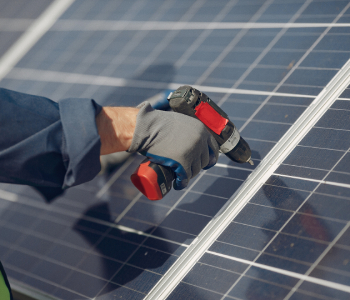Why Solar Energy Helps Reduce Your Carbon Footprint
Over the past few years, India has seen a soaring demand for reliable and affordable electricity. Rising energy costs, coupled with growing concerns about air pollution and climate change, have pushed many households to explore alternatives to traditional power sources. Solar energy has emerged as one of the most practical and effective renewable energy solutions available today.
With electricity prices climbing and power outages still common in many parts of India, families are increasingly rethinking how they power their homes. The good news is that the solution is readily available—solar energy from the sun. Thanks to falling prices and improved reliability of solar panels, harnessing sunlight for everyday energy needs is now accessible to more than just environmentalists or the wealthy.
Rooftop solar systems allow households to generate their own electricity, reducing dependence on coal-based grid power and cutting long-term costs. With India’s abundant solar potential, transitioning to solar is a practical choice. Whether you live in a city apartment or a standalone house in a smaller town, advancements in solar technology make it feasible to save on bills and reduce pollution from coal-fired power.
In this guide, we will explore how you can transition to a solar power system at home, the climate impact this will have on your household, and what you need to know before switching to solar.
What is a carbon footprint?
A carbon footprint refers to the total amount of greenhouse gases – mostly CO₂, CH₄ and N₂O – that you emit into the atmosphere as a result of daily activities. In the case of most Indian households, these activities include electricity use, cooking (particularly LPG or biomass), vehicle use, and also the way products are used and disposed of.
Electricity is one of the largest sources of CO₂ emissions from households. In India, more than 70% of the electricity consumed from the grid is generated from coal, the most carbon-intensive fossil fuel, with electricity consumption responsible for more than 30% of total global emissions. On average, generating 1 kilowatt hour (kWh) of grid electricity in India results in around 0.82 kg of CO₂ emissions. That means the household that saves 300 units (kWh) of grid electricity each month is emitting almost 3 tonnes of CO₂ emissions per year, measured indirectly from electricity generation and consumption.
By installing a solar power system, you can replace much of that amount, and in this case, cleaner, renewable energy will be generated right on your rooftop. Once the solar panels are installed, the system produces electricity without any combustion and therefore, no emissions occur from the use of the solar system after installation. Over an operational lifespan of 25 years, even a small solar power system can offset tens of tonnes of CO₂ emissions, which can have a substantial and measurable effect on your total household emissions.
Solar vs. Grid Electricity
- Electricity from fossil fuels (like coal and gas) emits between 820–900 g of CO₂ / kWh in India.
- Once solar panels are installed, solar power has nearly zero operational emissions.
- A rooftop installation of 5kW can save around 6 tonnes of CO₂ emissions per year – that’s a notable reduction to your carbon footprint over time.
Benefits of Solar in India
Solar energy provides the average Indian home with a dependable method of lowering electricity bills in states with high tariffs and regular outages. The large amount of sunlight available in almost all parts of India makes rooftop systems able to produce most, if not all, of the power needed for daily usage and reduce dependence on coal-based grid supply.
Various government subsidies and net metering policies, as well as falling prices for solar panels, mean that there has never been a better time to invest in solar energy. Switching to solar can deliver more than just financial savings; it can also reduce air pollution and carbon emissions, which have become a major issue in many parts of urban India.
Economic savings
- Lower electricity charges as the surplus amount of solar energy can be exported to the grid, thereby getting a credit via net metering.
- Government subsidies and incentives through the Ministry of New & Renewable Energy (MNRE) and various state schemes lead to reduced upfront costs.
Energy independence
- Less reliance on grid power and avoid outages/poor supply in unreliable supply areas.
- Electricity rates are only going to increase; with solar, you can know your energy costs.
Environmental benefits
- Clean energy generation with zero air pollution, zero emissions of CO2
- Every kWh of solar produced will avoid emissions of particulates and greenhouse gases, good for health and good for the climate.
Ways to Produce Solar Power in India
In India, solar power systems are typically available in three configurations: on-grid, off-grid, or hybrid. On-grid systems are grid-connected in both the household and utility, where you can use solar power (when available) and purchase electricity from the grid (when available). If you have a surplus of solar power, net metering allows you to export it to the grid.
An off-grid system is totally independent from the grid or utility, meaning you rely on batteries to store power for when the sun isn’t available to produce it. Off-grid solar power systems are ideal for rural areas where reliable electricity from the grid is unavailable.
A hybrid system has the benefits of both an on-grid solar power system and an off-grid solar power system, because hybrid systems internalize battery backup while also being grid-connected. A hybrid system is one of the most flexible and reliable types of solar power systems available.
On-Grid (Grid-Tied) Systems
Grid-tied systems connect your solar panel to the utility grid. Excess power your panels generate is transferred to the grid, and you’ll be credited for it on your electric bill through net metering. At night, or when the weather is cloudy, you will use grid generation.
Advantages
- Lower initial cost (no battery costs)
- Credits you through net metering for unutilized generation
Limitations
- No available power during the outage
- When the grid shuts down, your alternative source of energy relies on how much is being generated on the grid to work efficiently
Off-Grid Systems
Systems that operate independently off the grid and use batteries to store your solar energy when your solar panels are not generating energy. Off-grid systems are best suited for remote areas or if you’re living in a grid-reliant area.
Advantages
- Do not rely on the grid
- Extra benefits – Consistent power during long outages with battery storage
Limitations
- Costly depending on your battery storage.
- Routine battery maintenance and/or replacement.
Hybrid systems
- Hybrid systems combine on-grid and off-grid advantages, surplus energy is fed to the grid, and additional is stored in batteries to provide backup energy when there is an outage.
Benefits
- Best of both worlds: net metering, plus backup power!
- Flexibility and energy resiliency
Drawbacks
- Higher set-up costs than purely on-grid systems
Choosing the Best System for You
Choosing the best solar setup comes down to your energy needs, budget, and location. First, figure out your average electricity demand and whether you want backup power when it’s unavailable. If there is a good grid in your area, an on-grid system with net metering is usually the most economical.
If you live in an area with regular power cuts or where the grid is unavailable, you might be better served with an off-grid or hybrid set-up with battery storage. You’ll also need to consider your roof size, orientation, and sunlight access to ensure you achieve the best performance.
Estimate Your Load
- Make a note of your monthly grid electricity usage in kWh.
- Think about usage patterns: Do you need the backup due to frequent outages?
Roof Structure and Orientation
- South-facing panels with an angle of ~25-30° are the best orientation for sunlight capture in India.
- Consider the room available, shading and roof strength.
Sizing Your System
- Typical Indian household: systems sized from 3-5 kW can meet the majority of demand.
- You can sell excess surplus back to the grid through net metering provisions as per local utility rules.
Choosing equipment
- Use Tier‑1 solar panels with 25-year performance guarantees.
- Use certified inverters and quality batteries (if needed).
- Use vendors and installers that are approved by the government.
Government Incentives and Net Metering
Subsidies
Central and state governments regularly provide capital subsidies of 30 to 40 per cent for solar installations, particularly for residential rooftop installations.
Net metering policies
- Most Indian states include net metering, with surplus energy being exported back to the grid and being credited off your electricity bill.
- Policies vary by state: credit rollover, billing cycles, and there are limitations on how much can be exported.
Check with your local distribution company (DISCOM) for specifics.
- Maintenance and Durability
- Solar panels require little maintenance, periodic cleaning and occasional checks.
- Panels are manufactured to withstand the elements, and they are designed not to deteriorate faster than the warranty indicates.
Monitoring
- Most installers offer an app or web portal that allows you to monitor your daily generation and performance.
- This facilitates the ability to identify any drops in production in real-time.
Lifespan
- Most solar panels have a lifespan of 25 to 30 years, and most of the time, panels lose efficiency very slowly under 0.8 per cent in terms of performance, per year.
- The inverter is usually a component that will need to be changed in the 10 to 15-year mark.
- Batteries (in hybrid or off-grid systems) usually have a 5 to 10-year replacement schedule.
Common Queries
1. What is the installation timeframe?
In general, it takes 2–4 weeks from the signing of the contract to the final commissioning. There may be variations depending on local permits and grid connections.
2. What is the payback period?
With subsidies, a 5 kW system payback is 4–7 years in most Indian cities, depending on the electricity tariff and how you use the system.
3. Can I modify the installation later if I want to add batteries?
Yes! Hybrid systems are modular; you can start with an on-grid system and add batteries whenever you want if you feel you need to.
4. What happens if I move house?
Most rooftop solar systems can be dismantled and reinstalled; however, to relocate your solar system, the costs and logistics will vary.
Reducing Your Carbon Footprint with Solar Energy: Executive Summary
When you use solar panels, you can take control of your home energy, greatly reduce fossil fuel dependence, and minimize your carbon footprint – many times while saving money!
Solar energy in India is now universally friendly, reliable, and supported by policies. If you’re prepared, you can power your home with clean power for decades.
Conclusion
Investing in solar energy to reduce your carbon footprint is a lasting investment in your savings and the environment. Whether for your home, business or community space, choosing solar is a practical way to move toward energy independence in addition to a cleaner tomorrow.

